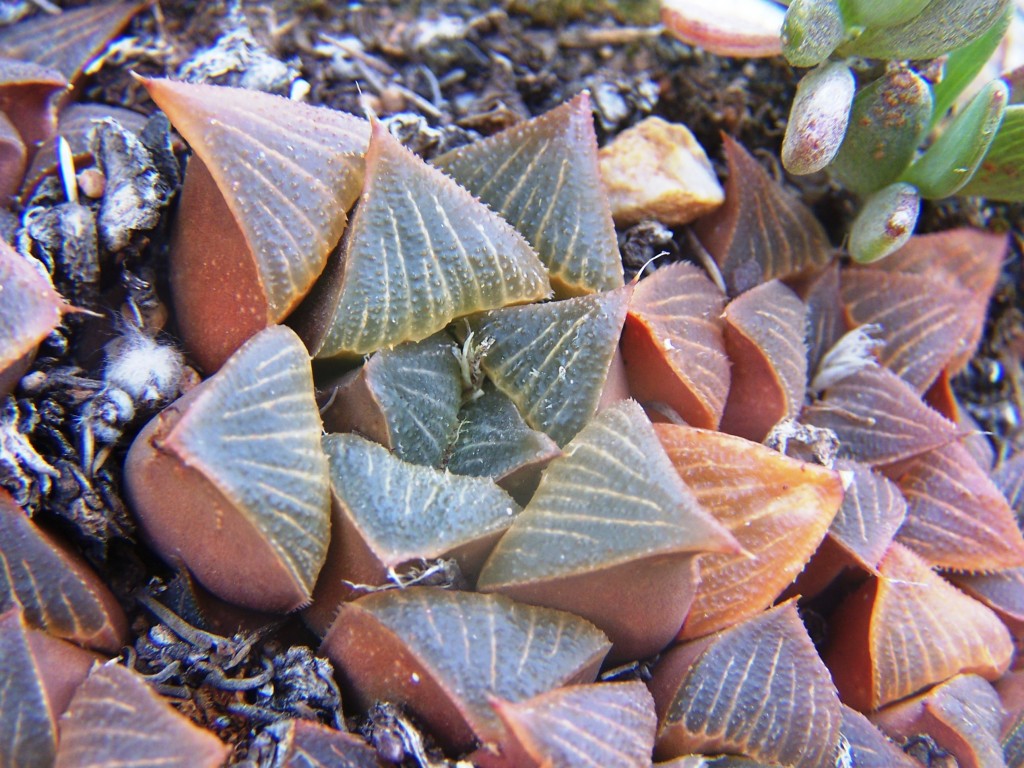18. Haworthia magnifica V.Poelln., Feddes Repert.Spec.Nov. 33:239(1933). Bayer, Natn.Cact.Succ.J 32:18(1977). Bayer :44(1982). H. maraisii var. magnifica (V.Poelln.) Bayer :131(1976). Type: Cape, Riversdale commonage, Mrs E. Ferguson. Not preserved. Lectotype (B&M): Riversdale, Ferguson (BOL).
magnifica: magnificent.
Rosette stemless, slowly proliferous, to 8 cm φ. Leaves spreading, retused to ground level, dark green to purplish, scabrid to finely spined margins, end-area slightly translucent between the veins, surfaces with small slightly raised tubercles. Inflorescence slender, to 40cm. Flowers brownish veined, few open, upper lobes pinched at tips.
1982 – Haworthia magnifica is an incredibly variable species and it will not be possible to gain any insight into probable affinities with H. turgida, H. retusa, H. emelyae and H. mirabilis without in‑depth study. It is characterized by its dark‑green colour, small size, short green‑lined buds and flowers, and ‘fish‑tail’ bud tips. It flowers in March ‑ April although this varies and only serves as a character to distinguish the species from H. mirabilis. Only the more notable and widely spread forms are recognized as varieties here. There are several other populations which could justly be named as varieties. The variety major has an unusually large flower similar to that of H. emelyae and there is evidence of intergradation of these two taxa. The var. paradoxa may constitute a south‑eastern link between H. magnifica and H. mirabilis, except that truer forms of H. magnifica var. maraisii intercede along the Breede River and at Bredasdorp. The var. maraisii at its type locality at Stormsvlei is quite a robust form which adopts many guises in the Robertson/Worcester area. South of Stormsvlei there is an aberrant population which appears intermediate between the var maraisii and H. mirabilis. However, just north of Stormsvlei, H. mirabilis occurs in a small, many‑leaved form. The var. meiringii appears vegetatively very like a smaller, darker green version of H. herbacea, until it flowers. Also to the west it intergrades into the more characteristic retuse‑leaved var. maraisii. The var. notabilis also has erect leaves which are darker green and more turgid than in the case of H. herbacea. The var. atrofusca was originally collected from west of Riversdale and is characterized by its rounded leaf tips. The var. magnifica has unusually long acuminate leaf tips and is restricted to a small area southeast of Riversdale, recurring again just west of Heidelberg. H. magnifica has been recorded north of both Montagu and Barrydale and as far south as Cape Infanta and westwards to Bredasdorp. Consideration of the variability of this species and distribution of variants is very helpful towards understanding variability in the genus as a whole.
1996 – The comment ‘in-depth study’ is quite inappropriate in the Haworthia literature which generally suffers from any formal objective study. What has happened since 1982 is much further collecting which has brought some new perceptions. The problems with this species are exemplified by Scott’s circumscription and synonymy of H. asperula where it is barely possible to separate all the diverse elements included in it. Esterhuizen wrote in ALOE (1996) that it was easier for him to separate the var. atrofusca from var. maraisii, than from magnifica. This perspicacious observation is all the more so for the new collections from east of Riversdale, and also for the changed view of H. heidelbergensis. It has been decided to separate the elements maraisii and magnifica because it appears that they relate to each other as H. heidelbergensis does to H. mirabilis. It is also more realistic that some of the varieties that were with magnifica are rather variants of H. maraisii. Thus H. magnifica is applied to the eastern populations which are rather more robust and in which the end-area of the leaf is longer and more pointed. If the end-area is shortened it is also rounded. H. magnifica is usually more greenish than the nearly black H. maraisii. Where previously considering H. retusa as a major element has led to problems, the perception that H. turgida and H. magnifica are the main role players makes it easier to understand what the different populations may represent. This should be apparent from the varieties recognised here, and in the corresponding discussion.

a. var. magnifica.
Originally from only south of Riversdale. The name is now also applied to the population from south of the Tradouw Pass, and to that just east of Riversdale. These are quite robust plants with rather scabrid, sub-tuberculate leaves with denticulation of the margins at least. The surfaces may also be slightly scabrid with the tubercles bearing small spines. The plants are lighter green in colour than H. maraisii.
Distribution: 3420 (Bredasdorp): Tradouw Pass (-BA), Smith 6788 (NBG). 3421 (Riversdale): S. Riversdale at beacon (-AA), Smith 5372 (NBG), Bayer in KG83/71 (NBG); Reserve (‑AB), J. Dekenah 16 (NBG); E. Riversdale (-AB), Smith 5376, 5376a, 5748 (NBG), Bayer in KG92/71 (NBG); Riversdale (-AB), Dekenah 6a (PRE); (-AB), Smith 5372 (PRE); Riversdale (-AB), Muir 3553 (PRE).
Inadequately located: Riversdale, Smith 3900, 5057 (NBG).

Haworthia magnifica var. magnifica JDV93/35 Tradouw Pass. The plants here are very variable and usually much greener than typical. 
Haworthia magnifica var. magnifica JDV93/13 south-east of Riverdale. Characteristic of these plants are the very dark colour and acuminate, retused leaf-tips. 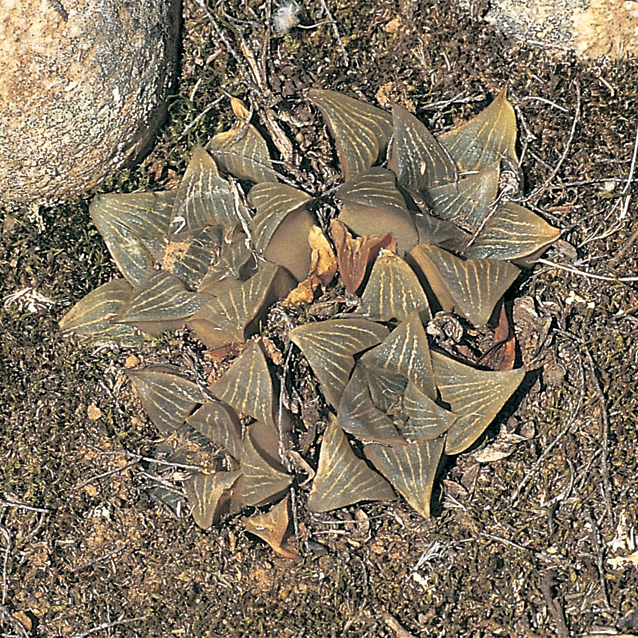
Haworthia magnifica var. magnifica JDV97/131 Also north-east of Riverdale. Two adjacent populations which show translation to H. retusa.
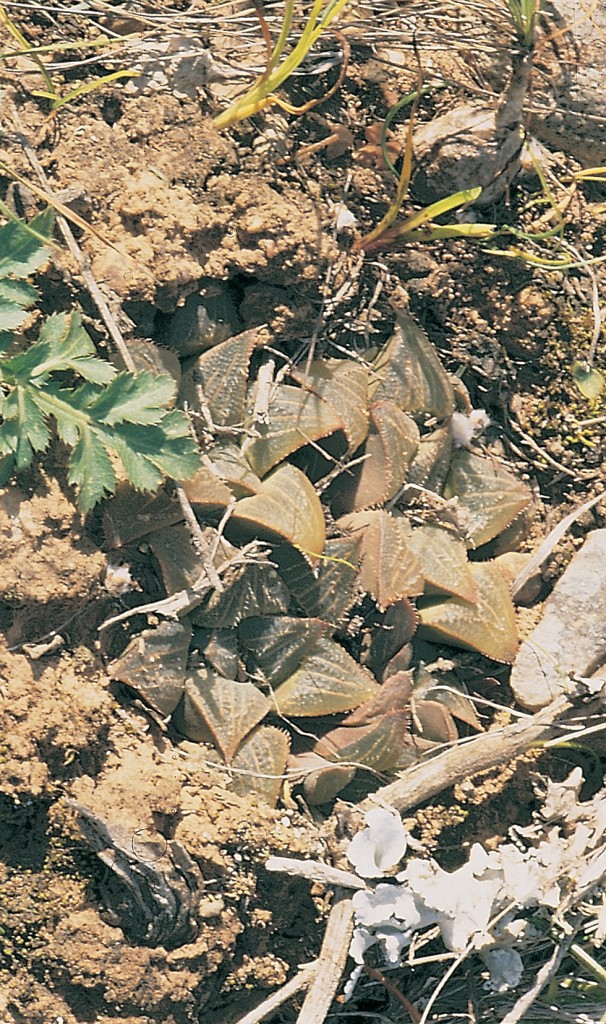
Haworthia magnifica var. magnifica JDV94/6 north-east of Riversdale is very similar to plants at Tradouws Pass. 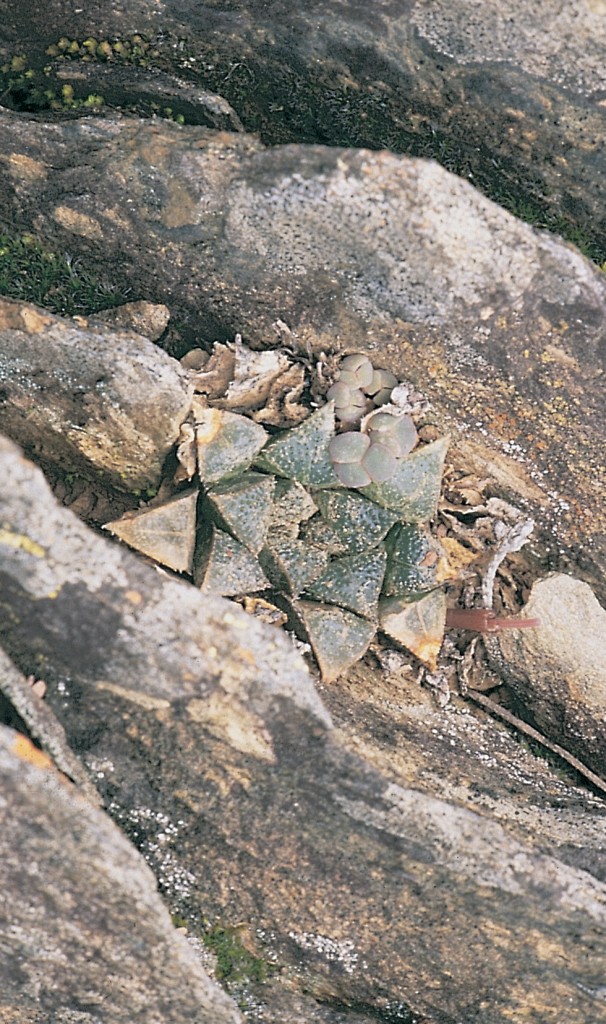
Haworthia magnifica var. magnifica JDV97/39 Barrydale. North of the Langeberg, these plants are more like H. maraisii. However, it seems probable that they will be shown to link up with H. emelyae var. major along the northern slopes of this range.
b. var. acuminata comb.nov.
H. retusa forma acuminata Bayer :94(1976). H. retusa var. acuminata Bayer :53(1982). Type: CAPE‑3421 (Riversdale): N. of Gouritzmond (‑BD), Bayer in KG 311/7 (NBG).
acuminata: sharp pointed.
Previously under H. retusa, this variety has been transferred here because of the now restricted view of that species, and the new concept of H. magnifica. It is only known from the one locality as the original nearby locality appears to have been destroyed.
Distribution: 3421(Riversdale): N. of Gouritzmond (‑BD), Bayer in KG 311/7 (NBG), Bayer 2423 (NBG); S. Gouritz Bridge (-BD), Smith 5047 (NBG); 9.5km Gouritz to Albertskraal (-BD), Smith 3946 (NBG).

Haworthia magnifica var. acuminata JDV94/94 north of Gouritzmond. The leaf-tips are much more acuminate than in H. retusa, and the plants are darker green. 
Haworthia magnifica var. acuminata JDV91/39 north of Gouritzmond. Plants are proliferous.
c.var. atrofusca (Smith) Bayer
Natn.Cact.Succ.J 32:18(1977). Bayer :44(1982). H. atrofusca Smith, JS.Afr.Bot. 14:41(1948). Bayer :100(1976). Scott :130(1985). Type: CAPE‑3421 (Riversdale): (‑AA), J. Dekenah 225 in Smith 6169 (NBG).
atrofusca: very dark brown.
This variety was represented by a single small population to the west of Riversdale and characterised by the blunt rounded leaf-tips. This is in effect a single character which occurs in other populations and other species. The scope of the variety is widened to include the large element to the north and west of Riversdale collected mostly by C. Craib (unpublished). These are large brownish-green to blackish plants which are densely and finely tubercled against a scarcely translucent background. The original variety and populations to the west include forms with sharply pointed leaves. There is a very interesting population in the Potberg area to the west of the Breede River. The habitat is identical to that of the type locality. It is very unusual to encounter such a vicariant distribution record in the genus where isolated plants so closely resemble the type.
Distribution: 3420 (Bredasdorp): NW. Kathoek (-AD), Bayer & Bruyns 6549 (NBG). 3421(Riversdale): (‑AA), J. Dekenah 225 in Smith 6169 (NBG), Bayer in KG202/70 (NBG); Droerivier (-AA), Bayer 2665 (NBG).

Haworthia magnifica var. acuminata JDV90/91 west of Riversdale. Leaf-tips rounded. 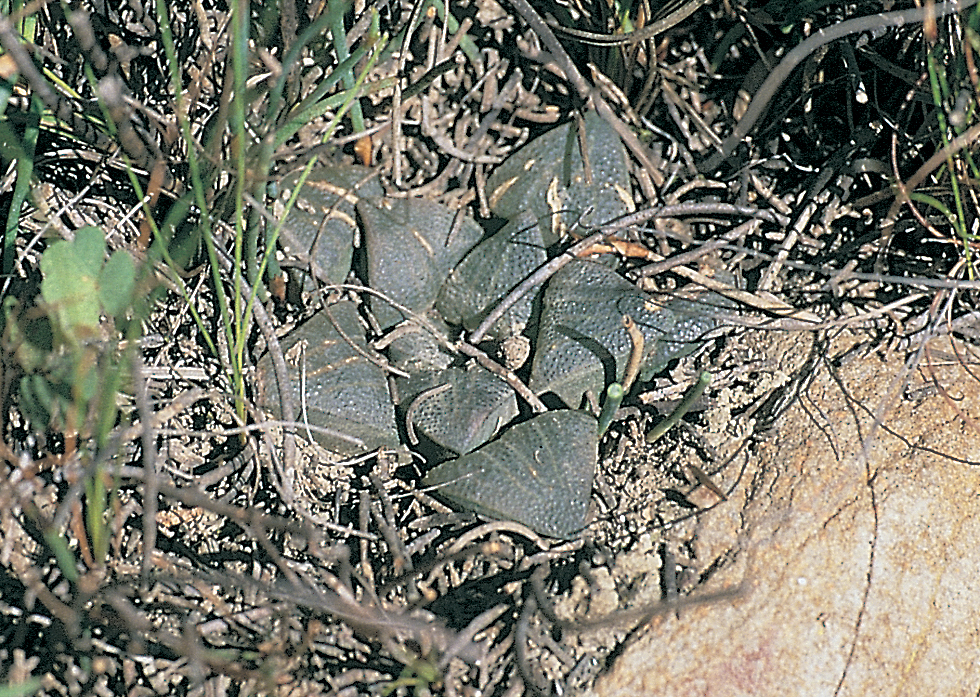
Haworthia magnifica var. acuminata JDV97/146 west of Riversdale. Leaf-tips rounded. The ‘aubergine’ locality of C. Craib. 
Haworthia magnifica var. atrofusca JDV90/91 west of Riversdale. The dark coloured species seem to need more protection from direct sunlight. 
Haworthia magnifica var. acuminata JDV92/97 north-west of Riversdale. More robust plants with even more rounded leaf-tips.
d. var. dekenahii (Smith) Bayer comb.nov.
H. dekenahii Smith, JS.Afr.Bot. 10:140(1944). H. retusa var. dekenahii (Smith) Bayer :53(1982). Type: Cape, on farm Draaihoek (-BA), J. Dekenah 86 in Smith 5489 (NBG).
dekenahii: for Japie Dekenah, a born naturalist.
This element as a species was completely discarded in the 1976 handbook and resurrected as a variety of H. retusa in 1982. Col. Scott upholds it as a species but illustrates H. turgida var. pallidifolia which co-occurs with it. The significant things about this variety are the raised tubercles on the leaves, the silver flecks, and the blunt rounded leaf-tips.
Distribution: 3421 (Riversdale): Draaihoek (-BA), J. Dekenah 86 in Smith 5489 (BOL,NBG,PRE).

Haworthia magnifica var. dekenahii JDV87/146 north-west of Albertinia. Plants are fairly scabrid, darkish-green and the leaf-tips are rounded. 
Haworthia magnifica var. dekenahii JDV87/146 north-west of Albertinia. Plants do not proliferate and can be very cryptic.
e. var. splendens Hammer and Venter
Cact.Succ.J(U.S.) in ms. Type: W. Albertinia (-BA), Venter (NBG).
splendens: splendid.
The name is indeed apt. I first saw this plant in about 1970 in a visit to Dr Hans Herre. I simply assumed the unlabelled pinkish-red plant with the shiny black raised tubercles was an unusual specimen of H. emelyae which itself was practically unknown to me at that time. The full story of this variety is better told by the authors whose persistence and tenacity led to its rediscovery at what is presumed to be a second locality – the first apparently having been destroyed. Strangely enough a further population was discovered fatefully, and perhaps fortuitously, by Mary Parisi and Ed Dunne to the east of Albertinia. The word fatefully are used with some deliberation because these two people deliberately avoided the contamination of plans aforethought in wanting to do their own exploration and discovery. This eastern population flowers earlier together with the var. acuminata and also with H. emelyae. There is obviously some significance to this which implies some cross-mountain connection and throws some doubt on the relation of the H. emelyae varieties.
Distribution: 3421 (Riversdale): E. Albertinia (-BA), Marx sn. (NBG); W. Albertinia (-BA), Venter (NBG).

Haworthia magnifica var. splendens JDV97/127 Albertinia. Spectacular glazed pieces of pottery. 
Haworthia magnifica var. splendens JDV93/59 west of Albertinia. The tubercles on the leaves can be very dark coloured. 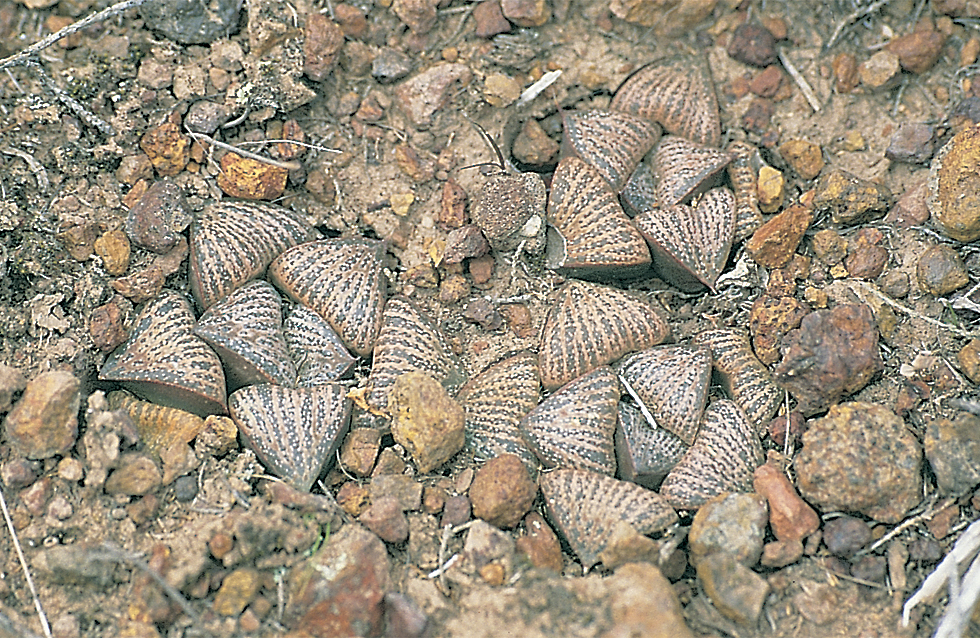
Haworthia magnifica var. splendens JDV97/127 Albertinia. Possibly this is the spot where Herre first collected this variety. 
Haworthia magnifica var. splendens Kent sn. Originally collected by Dr. Hans Herre from west of Albertinia. 
Haworthia magnifica var. splendens JDV93/59 west of Albertinia. Rediscovered by Venter, Kent and Marx. Flowers here in late summer. 
Haworthia magnifica var. splendens JDV94/108 east of Albertinia. The leaf surface in this population are very mottled. Flowering time is in the spring although it seems as though the plants may also flower in late summer in cultivation. 
Haworthia magnifica var. splendens JDV94/108 east of Albertinia. Plants from here have more acuminate leaves than in plants from west of Albertinia; also the leaf-tips are densely white-spotted.

